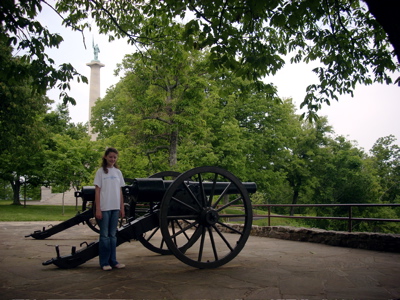
Atlanta
History
Gone With The Wind
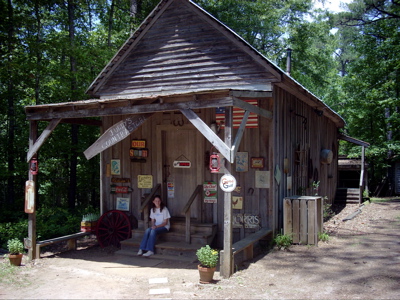
| Route 66 | Cities | Beaches |
 |
Atlanta History Gone With The Wind |
 |
A long Atlanta weekend is good for visiting restaurants, railroads, and a long list of miscellaneous attractions, but the central point of coming is still the Civil War history represented by Gone With The Wind. Starting in Chattanooga and spending a whole day moving South, there is one battlefield after another. Once in Atlanta there are numerous sites to see. You need a good camera, hiking shoes, and a water bottle. Eight months a year, you should expect heat and humidity. Especially on weekends, you should expect crowds. They come from all over the world and especiually the nation to see these places. The sites close at 5 pm, so you need to get an early start. And if you're bringing a group, you need advance arrangements. This is Big History here, equalled only by Massachusetts, Williamsburg and The Alamo. |
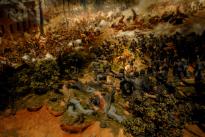 |
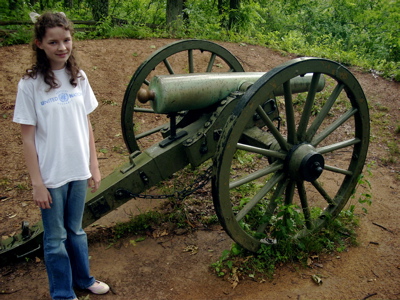 |
The main reason you spend the first night in Chattanooga is Lookout Mountain. This is where they fought the famous Battle Above The Clouds. The Confederates knew Sherman was coming, and they knew he had to have this mountain. They spent time, gold and effort fortifying it. When Sherman looked up at this fortress he shook his head. Lookout Mountain is a five mile long ridge lining the south edge of the city. It was the only access to Georgia. It is high and steep with house sized boulders strewing the bottom slopes and cliffs up the top half mile all around. With cannon and musket fire raining down on them, Sherman knew he would incur tremendous losses getting his men to the top, but there was no way around it. Someone could write a whole novel or make a movie about this one battle. To study it, you take the Lookout Mountain Scenic Railway up to the top, then hike a mile along the ridgetop to the national park, where there are various observation points, displays, monuments, plaques and other indicators of what happened here. Across the street from the national park entrance is also a limestone building housing a model of the mountain with men and cannon in place to help you visualize the battle. |
From Chattanooga, you'll pass battle sites all the way to Atlanta : Resaca, New Hope Church and Dalton. The one you must stop at is Kennesaw Mountain. This is the battle described in Gone With The Wind as Scarlett could hear the cannon in the distance, The Home Guard was marching out to help, and Aunt Pittypat was fainting. The Battle of Kennesaw Mountain went on so long and was so bloody the streams ran red. Sherman bombarded the hills with cannon until the trees were gone but could not dislodge the Confederate stations. They dug themselves so deeply into the slopes that the depressions and mounds of dirt are still clearly visible 148 years later. From Kennesaw Mountain you looking down into Atlanta , so this was The Last Stand and the Confederates hung on grimly. There's a visitor center, museum, gift shop and various tours and presentations. A paved road winds up the mountain. There are monuments and plaques marking every stage of the battle, and original cannon are in place on their original positions. Shermanwrote that his failure to capture Kennesaw after two weeks battle and the worst losses of his career haunted him. He had to march 40 miles around to find an alternate route to the city, which gave the Confederates time to pull back and set their defenses at the river. Were this not a bloody battleground, it could still be a major park because it's a beautiful mountain, covered in deep forest, with sparkling streams and breathtaking views. You should spend at least an hour here and could spend an afternoon. |
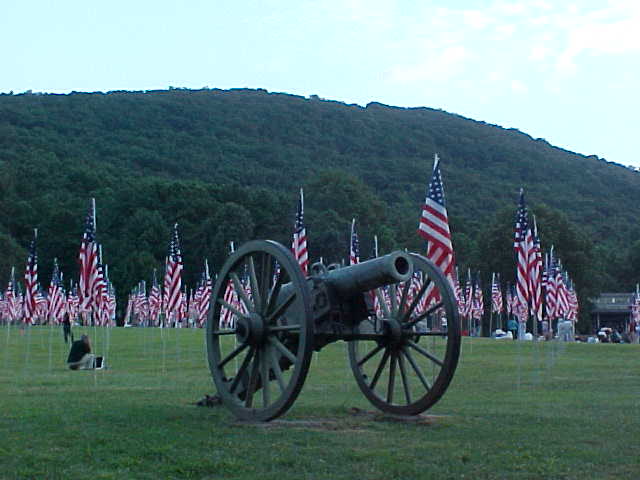 |
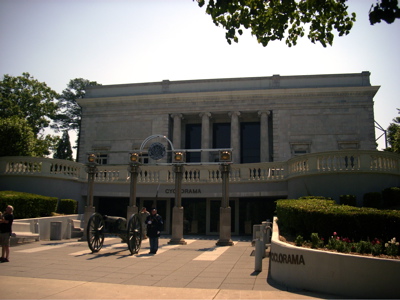 |
Once in Atlanta, your first stop should be Cyclorama. There are only two of these left, at Gettysburg and here. A Cyclorama is a giant circular 42 feet high room with the outside wall a continuing 358 feet painting leading seamlessly down into a 3D diorama. You sit on a revolving platform, where as you slowly turn a narrator explains what you are seeing. Here, what you are seeing is The Battle of Atlanta from a supposed vantage point of the hilltop where The Carter Center Fountain is now. Detail is astounding. You need three times around to study all the various scenes within scenes, and since you only get one, you never fully digest the panorama laid out before you. In addition to the Civil War history presented here, there is a side history to Cyclorama itself. Originally created as a travelling attraction, it has been mounted on the wall here permanently, but underwent a three year, 11 million dollar restoration in 1979 to bring back the colors. There's also a museum, gift shop and bookstore in the building, which houses the Texas, the other locomotive in The Great Locomotive Chase (The General is housed at Kennesaw). Cyclorama is open from 9 - 4:30 except Mondays. |
| Stately Oaks is obviously central to the Gone With The Wind / Civil War History trip because it is the plantation Margaret Mitchell made famous as Tara. She borrowed the name Tara from the road that runs past the plantation. Stately Oaks is outside Jonesboro, 15 miles South of Atlanta. The 1839 plantation is meticulously preserved, with slave quarters, furniture and grounds just as they were the day Yankee troops showed up at the front door. Much against the wishes of Mitchell, Cecil B. DeMille created a different mansion for the movie, but if you bring the novel, you can match descriptive paragraphs with both the outside and inside. Stately Oaks offers hourly tours, and by advance arrangement they have various educational programs for school groups. Take I-75 South, take Exit 233, follow Route 54 South to Jonesboro, and at the Road To Tara Museum look for the left turn across the tracks. Stately Oaks is the first plantation out of town, just around the bend, on your left. Tours depart on the hour. If you arrive early, there are shady benches and of course the beautiful grounds to explore. | 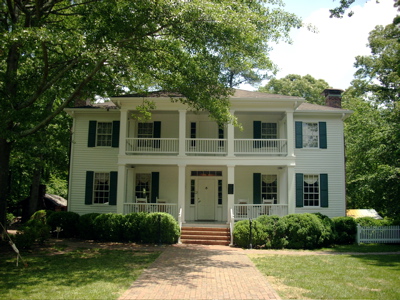 |
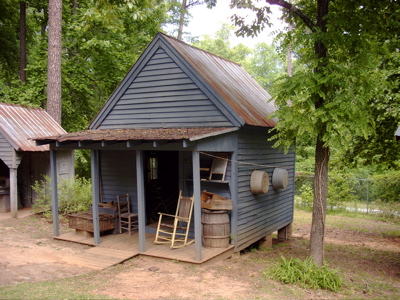 |
Jonesboro is much more than Stately Oaks and the Tara experience. The Road To Tara Museum is a mandatory stop. The gift shop is filled with books and GWTW memorabilia. Stop at the 1800s Judd's General Store (photo top right) for a sody pop, fresh local peanuts, and Moonshine Jelly. There are old slave quarters (left), Bethel One Room School House (1900), The Cook House (1839)(right), made of hand hewn logs and square peg nails and in use during the Civil War, and various other historical sites. The town of Jonesboro today is still a charming, gracious Southern village. The railroad still runs down the main street, just as Mitchell described it. | 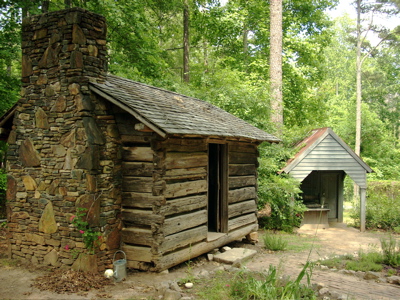 |
| Margaret Mitchell's Home is a mandatory stop. This is where she wrote Gone With The Wind. You can take a narrated tour, and there's a gift shop. The rooms are furnished exactly as they were, down to her typewriter. In her lifetime, this house was on the edge of the city, looking across a sweeping meadow (where as a girl she rode her pony) to the bustling downtown. She could walk to work at the newspaper office or to shop. Today, the house is in the middle of the city, and an eight lane interstate runs where the meadow was, separating this house from the downtown. This photo shows the front of the house. The rooms she spent her time in, including the table where she worked, looked out to the rear, toward the city. She had a clear view of "Five Points," and the rising skyline. | 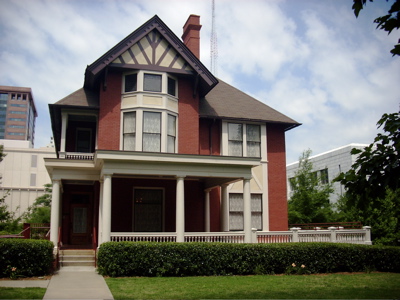 |
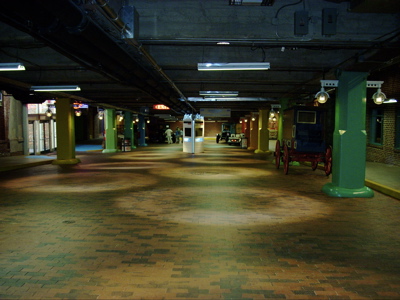 |
Underground Atlanta makes a great final stop on a Gone With The Wind History Tour. Legend has it the city was in such shambles it would have taken decades to level everything, so they just erected a new surface and built the new city on top of it. The new city began at the second floor level of the previous one. They sealed it over and forgot about it. In 1960, starting to excavate for a MARTA system, they discovered the old city, which was really only a town a few blocks long and wide. They restored it, let new shops and restaurants move in, and opened it to the public as Underground Atlanta. Today, you can walk the cobblestone and brick streets, admire the 1800s brick storefronts and streetlamps, and catch a meal in one of the restaurants. They've parked various horsedrawn vehicles along the curbs and placed other artifacts in appropriate locations. Most of the people are just there for the shopping and recreation, oblivious to the history. But take your copy of Gone With The Wind, sit on the steps at the main intersection, read a few paragraphs and look around. This is Margaret Mitchell's Atlanta. Not the one she grew up in, but the one she heard described by her grandparents. The one she wrote about. Scarlett's. |
|
|||
|